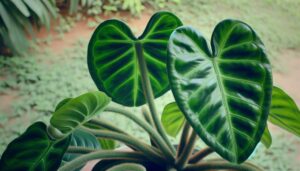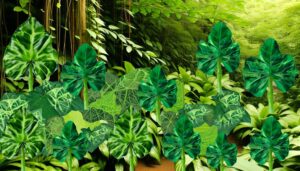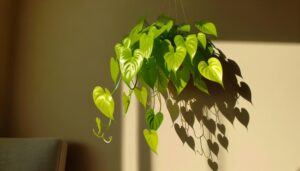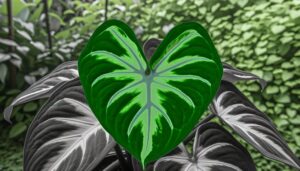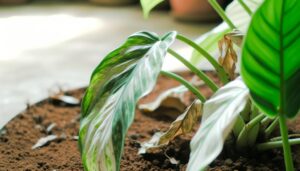What Is a Philodendron Erubescens Grey?
Philodendron erubescens 'Grey' is an exceptional tropical plant native to Colombia, notable for its elongated, heart-shaped leaves measuring 20-40 cm in length. The foliage features a distinctive silvery-grey hue with subtle variegations and reddish undertones, conferring an exotic aesthetic.
This cultivar exhibits a vigorous climbing growth habit supported by aerial roots. Optimum growth occurs in temperatures of 18-27°C, with medium to bright indirect light and well-draining soil.
Regular application of a balanced 20-20-20 fertilizer and high humidity enhance its health. Those intrigued by unique botanical specimens will find further information intriguing.
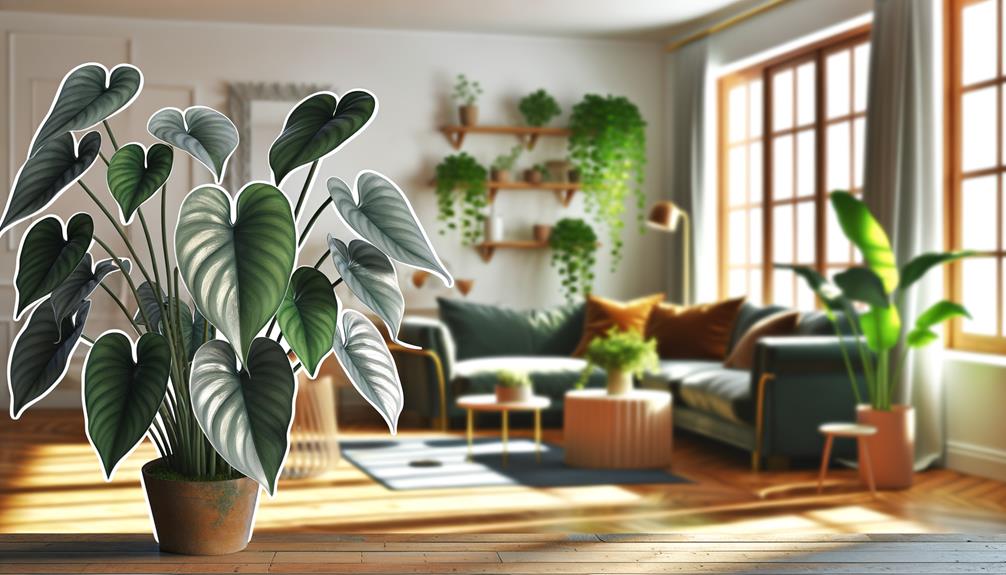
Key Takeaways
- Philodendron Erubescens Grey is a climbing plant originating from Colombia's tropical rainforests.
- It features elongated, heart-shaped leaves with a unique silvery-grey hue and reddish undertones.
- The plant thrives in medium to bright indirect light and requires consistently moist soil and high humidity.
- Ideal soil mix includes peat moss, perlite, and orchid bark for aeration and moisture retention.
- Propagation is commonly done through stem cuttings, either in water or well-draining soil.
Origin and History
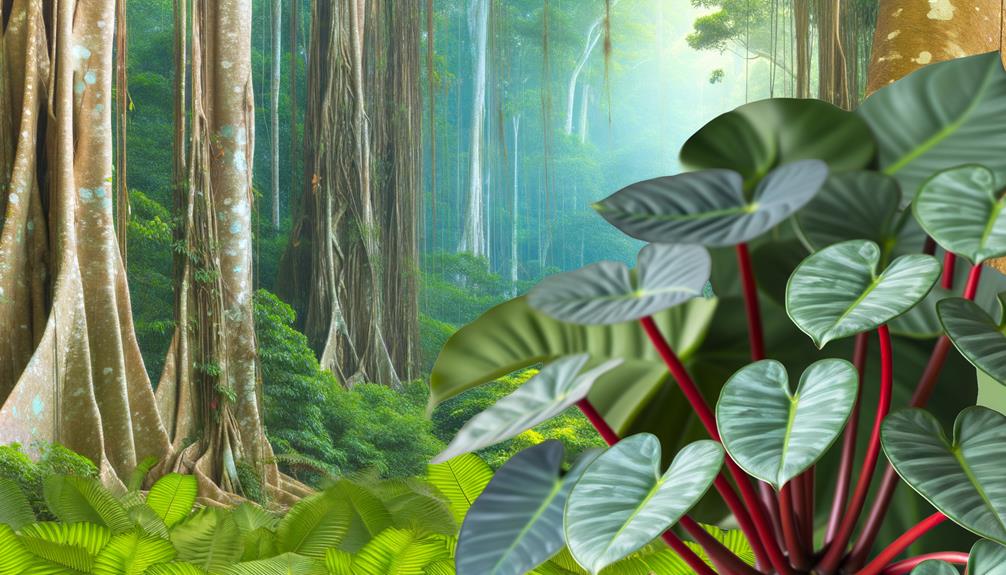
Philodendron erubescens 'Grey', a cultivar of the species Philodendron erubescens, originates from the tropical rainforests of Colombia.
This cultivar, like its parent species, thrives in the understory of dense forest canopies, benefiting from high humidity and dappled sunlight.
The Philodendron genus, part of the Araceae family, was first described by German botanist Heinrich Wilhelm Schott in the 19th century.
Philodendron erubescens itself gained attention for its striking appearance and adaptability as an ornamental plant.
The 'Grey' cultivar, selectively bred for its distinctive foliage, has become a popular choice among plant enthusiasts and horticulturists.
Its introduction into cultivation has contributed to the diversification of indoor plant varieties, emphasizing unique aesthetic traits while retaining the species' resilient nature.
Physical Characteristics
The Philodendron Erubescens Grey exhibits distinctive physical characteristics, including elongated, heart-shaped leaves that can reach up to 30 centimeters in length.
The foliage presents a unique silvery-grey hue, often accented with subtle variegations and reddish undertones.
This species demonstrates a climbing growth habit, supported by aerial roots that enable it to attach to various surfaces.
Leaf Shape and Size
Characterized by its distinctive elongated, heart-shaped leaves, *Philodendron erubescens* 'Grey' exhibits a unique morphology that differentiates it from other cultivars within the Araceae family. The leaves are typically lanceolate, extending to lengths of 20-40 cm and widths of 15-20 cm, providing a substantial foliage presence. The petioles, robust and semi-glossy, support the substantial blades with precision, ensuring ideal light absorption for photosynthesis. The following table highlights key leaf metrics:
| Leaf Attribute | Measurement Range |
|---|---|
| Length | 20-40 cm |
| Width | 15-20 cm |
| Shape | Elongated, Heart-shaped |
| Petiole Length | 10-15 cm |
| Thickness | Medium |
Such dimensions underscore the plant's capacity for vigorous growth and its ornamental appeal in both residential and commercial spaces.
Color and Patterns
Interestingly, the foliage of *Philodendron erubescens* 'Grey' showcases a distinctive blend of silvery-grey hues with subtle variegations, enhancing its visual appeal and distinguishing it from other species within the genus.
The leaves display an enchanting interplay of colors, ranging from soft, pearlescent greys to deeper, more muted shades, often accentuated by delicate, feathery patterns. These variegations manifest as irregular streaks or patches, creating a striking contrast against the primary leaf color.
The underside of the leaves may exhibit a slight reddish tint, adding another layer of complexity. This unique coloration not only provides an aesthetic allure but also indicates the plant's health and vigor, signaling robust chlorophyll activity and efficient light absorption.
Growth Habit
Displaying a climbing growth habit, *Philodendron erubescens* 'Grey' utilizes its aerial roots to anchor onto surfaces, allowing it to ascend vertically and spread horizontally in suitable environments.
This climbing nature facilitates significant vertical growth, often making the plant an excellent choice for trellises or moss poles. The stems are robust and elongated, providing structural support to the large heart-shaped leaves. The leaves themselves exhibit a unique greyish-green hue, adding an aesthetic appeal.
Internodal spacing is moderate, ensuring a dense foliage arrangement. As it matures, the plant can achieve substantial height, often exceeding several meters, contingent on support availability.
Ideal growth conditions include indirect light, high humidity, and well-draining soil to mimic its native tropical habitat.
Ideal Growing Conditions
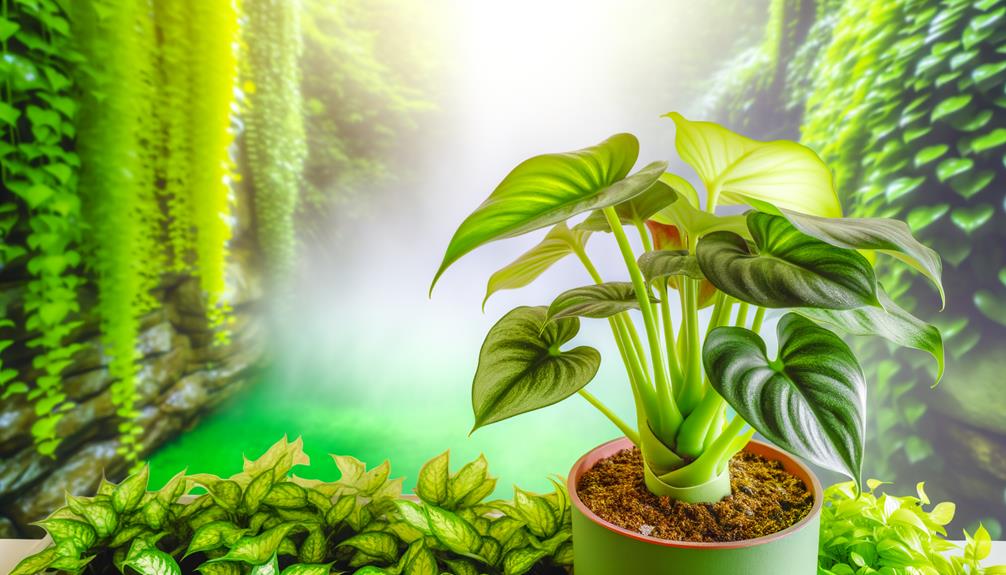
Philodendron erubescens 'Grey' thrives most under medium to bright indirect light, with temperatures ranging between 18-27°C (65-80°F).
Proper watering practices include maintaining consistently moist but not waterlogged soil, complemented by a high humidity environment, typically above 60%.
These conditions contribute to best growth and vibrant foliage, ensuring the plant's health and aesthetic appeal.
Light and Temperature Needs
The Philodendron erubescens 'Grey' thrives in bright, indirect light and maintains peak growth when temperatures are consistently between 65°F and 80°F (18°C to 27°C).
Best light conditions involve placing the plant near a north or east-facing window, where it can receive filtered sunlight. Direct sunlight should be avoided as it can scorch the leaves, causing discoloration and reduced vigor.
This species is highly adaptable to lower light conditions, although growth may be slower. Temperature fluctuations outside the ideal range can stress the plant, leading to stunted growth and potential leaf drop.
Ensuring a stable environment, free from cold drafts and sudden temperature changes, will support the Philodendron erubescens 'Grey' in achieving robust, healthy development.
Watering and Humidity Requirements
Maintaining optimal hydration for Philodendron erubescens 'Grey' involves keeping consistently moist, but not waterlogged, soil conditions. This delicate balance prevents root rot while promoting healthy growth.
Adequate humidity is also essential for this tropical species, ideally between 60-80%.
Here are key watering and humidity guidelines:
- Watering Frequency: Water the plant when the top 1-2 inches of soil feel dry to the touch, typically every 7-10 days, adjusting for seasonal changes.
- Humidity Maintenance: Utilize a humidifier or place a tray of water near the plant to maintain ideal humidity levels.
- Drainage: Ensure the pot has ample drainage holes to prevent water accumulation, which can lead to root rot.
Light Requirements
Best development of Philodendron erubescens 'Grey' requires exposure to bright, indirect light, imitating the understory conditions of its native tropical habitat. Direct sunlight can cause leaf scorch, while insufficient light may lead to etiolation, characterized by elongated, weak stems and diminished foliage color.
Ideal placement is near north-facing windows or areas filtered by sheer curtains, ensuring ample light without direct sun exposure. Artificial grow lights with a balanced spectrum can supplement natural light, especially during shorter daylight periods.
Consistent light conditions are optimal for maintaining the plant's variegation and overall health. Monitoring the plant's response to its lighting environment and making necessary adjustments can prevent potential issues related to improper light exposure.
Watering Needs
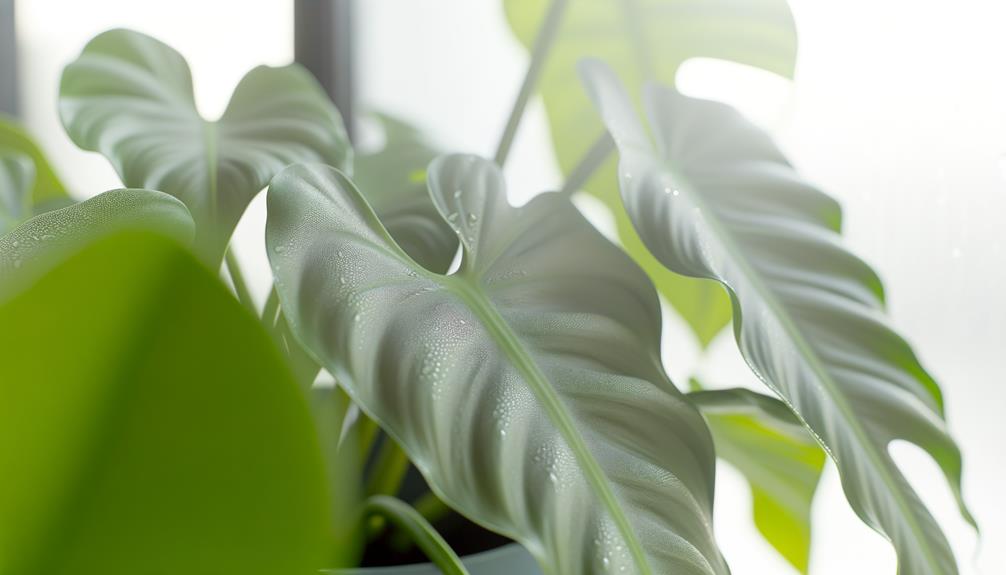
Proper watering practices are essential for the health of Philodendron erubescens 'Grey', as it thrives in consistently moist yet well-draining soil that mimics its humid, tropical origins. To achieve peak hydration, consider the following guidelines:
- Frequency: Water the plant when the top inch of soil feels dry to the touch. Avoid letting the soil dry out completely.
- Method: Use room-temperature water and ensure thorough watering until it flows out of the drainage holes, preventing waterlogging.
- Humidity: Maintain high humidity levels, ideally between 60-80%, by using a humidifier or placing a water tray nearby.
Adhering to these practices will promote robust growth and prevent common issues such as root rot and leaf yellowing.
Soil Preferences
Philodendron erubescens 'Grey' thrives in a well-ventilated, organically rich soil mix that provides sufficient drainage while retaining enough moisture. Ideal soil composition includes a mix of peat moss, perlite, and orchid bark. Peat moss ensures moisture retention, while perlite improves aeration and prevents soil compaction.
Orchid bark contributes to the soil structure, promoting root health and preventing waterlogging. A pH level between 5.5 and 6.5 is best, creating a slightly acidic environment favorable for nutrient availability. Regularly evaluating soil conditions is essential, as compacted or excessively wet soil can lead to root rot.
Adding organic matter, such as compost or aged leaf mold, can further boost nutrient content, supporting the plant's robust growth and lush foliage.
Fertilization Tips
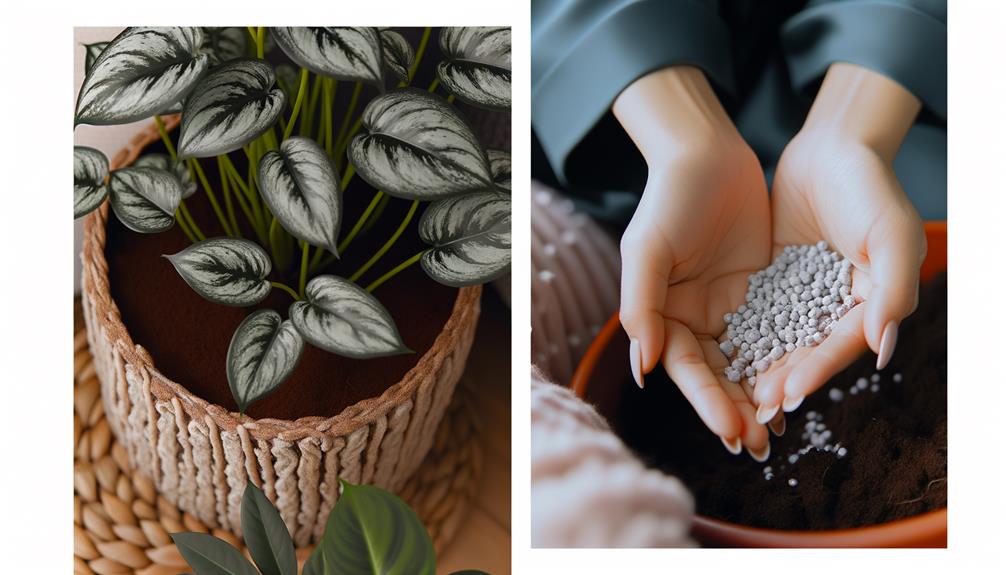
For ideal growth, Philodendron erubescens 'Grey' requires a balanced fertilization regimen that supplies essential macro and micronutrients. Proper fertilization guarantees robust foliage and healthy root systems.
Here are three key tips for best fertilization:
- Balanced Fertilizer: Use a balanced, water-soluble fertilizer with an N-P-K ratio of 20-20-20. Apply every 4-6 weeks during the growing season (spring and summer).
- Micronutrient Supplementation: Incorporate trace elements such as iron (Fe), manganese (Mn), and zinc (Zn) to prevent deficiencies and promote vibrant leaf coloration.
- Dilution and Application: Dilute the fertilizer to half the recommended strength to avoid root burn. Apply to moist soil to ensure uniform distribution and absorption by the root system.
Following these guidelines will promote the health and vigor of your Philodendron erubescens 'Grey'.
Pruning and Maintenance
How can you guarantee maximum growth and aesthetic appeal for your Philodendron erubescens 'Grey' through strategic pruning and meticulous maintenance practices?
Regular pruning plays a pivotal role. Employ sterilized pruning shears to remove dead or yellowing leaves, which can harbor pathogens. Trim leggy stems to promote denser foliage growth, targeting nodes where new shoots can emerge.
Maintenance also involves wiping leaves with a damp cloth to remove dust, ensuring ideal photosynthesis. Examine the plant routinely for signs of stress or nutrient deficiency.
Consistent watering practices, allowing soil to dry between waterings, and appropriate humidity levels prevent root rot and other issues.
Lastly, repotting every 2-3 years with well-draining soil supports healthy root development.
Common Pests and Diseases
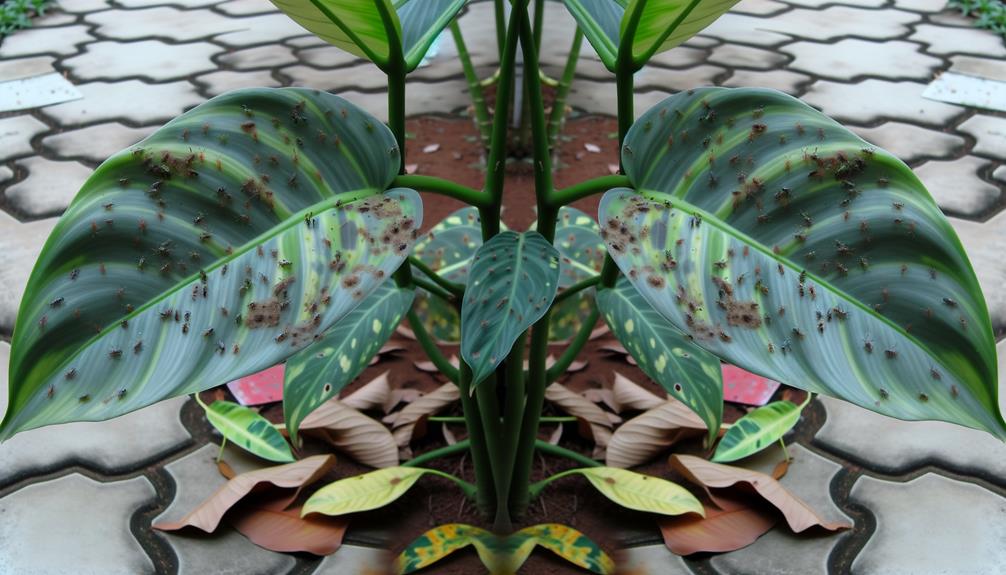
Effective management of pests and diseases is crucial to maintaining the health and vigor of Philodendron erubescens 'Grey'. Common issues include infestations by spider mites (Tetranychus urticae) and scale insects (Coccoidea), as well as fungal infections like root rot caused by Pythium spp. Regular monitoring and appropriate intervention can prevent severe damage.
- Spider Mites (Tetranychus urticae): These tiny arachnids cause stippling and discoloration on leaves, typically managed through miticides or neem oil.
- Scale Insects (Coccoidea): These pests attach to stems and leaves, sucking sap and weakening the plant. Insecticidal soap or systemic insecticides are effective treatments.
- Root Rot (Pythium spp.): Manifesting as wilting and blackened roots, this fungal disease requires well-draining soil and proper watering practices to prevent occurrence.
Propagation Methods
Propagation of Philodendron erubescens 'Grey' can be efficiently achieved through specific techniques, each with its own set of procedures.
The stem cutting method involves selecting healthy nodes and preparing them for either water or soil propagation.
Detailed steps for water propagation and practical tips for soil propagation will guarantee successful plant reproduction.
Stem Cutting Technique
To propagate Philodendron erubescens 'Grey', a stem cutting technique involving the excision of a healthy section of the stem with at least one node and aerial root is employed. This method guarantees the cutting has the necessary structures for successful growth.
Here is a detailed approach to the technique:
- Selection: Choose a vigorous stem section, making sure it contains at least one node (the point where leaves and roots originate) and an aerial root for best nutrient uptake.
- Cutting: Use sterilized pruning shears to make a clean cut below the node. This prevents infection and facilitates quicker healing.
- Preparation: Allow the cutting to dry for a few hours to form a callus, reducing the risk of rot during the rooting phase.
This method ensures robust propagation and healthy new plants.
Water Propagation Steps
Water propagation offers an efficient and visually engaging method for rooting Philodendron erubescens 'Grey' cuttings, ensuring ideal hydration and growth.
Begin by selecting a healthy stem cutting, approximately 4-6 inches in length, with at least one node. Remove any lower leaves to prevent submersion in water, which could lead to rot.
Place the cutting in a transparent container filled with water, ensuring the node is fully submerged. Position the container in a location with bright, indirect light.
Change the water every 5-7 days to maintain oxygen levels and prevent bacterial growth. Within 2-4 weeks, roots should begin to develop.
Once roots are 2-3 inches long, the cutting is ready for transplantation.
Soil Propagation Tips
For those preferring a more traditional approach, soil propagation of Philodendron erubescens 'Grey' involves careful preparation and monitoring to guarantee successful root development and plant health. Begin by selecting a well-draining potting mix rich in organic matter. A blend of peat moss, perlite, and orchid bark works well.
Follow these steps:
- Cuttings Preparation: Obtain a healthy stem cutting with at least one node and several aerial roots. Remove lower leaves to prevent decay.
- Planting: Insert the cutting into the prepared soil, making sure the node is buried. Firm the soil gently around the cutting.
- Aftercare: Maintain a humid environment and consistently moist soil, avoiding waterlogging. Position the pot in indirect, bright light to facilitate root growth.
This method secures robust, healthy plants.
Conclusion
To sum up, Philodendron erubescens 'Grey' flourishes under specific conditions, such as indirect sunlight, moderate watering, and well-draining soil.
Adequate fertilization, trimming, and pest control are crucial for ideal growth.
Reproduction through stem cuttings guarantees the continuation of this distinct variety.
From a botanical perspective, 'an ounce of prevention is worth a pound of cure' emphasizes the significance of timely maintenance to avoid possible problems, safeguarding the plant's well-being and longevity.

